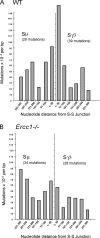Deletion of the nucleotide excision repair gene Ercc1 reduces immunoglobulin class switching and alters mutations near switch recombination junctions
- PMID: 15280420
- PMCID: PMC2211985
- DOI: 10.1084/jem.20040052
Deletion of the nucleotide excision repair gene Ercc1 reduces immunoglobulin class switching and alters mutations near switch recombination junctions
Abstract
The structure-specific endonuclease ERCC1-XPF is an essential component of the nucleotide excision DNA repair pathway. ERCC1-XPF nicks double-stranded DNA immediately adjacent to 3' single-strand regions. Substrates include DNA bubbles and flaps. Furthermore, ERCC1 interacts with Msh2, a mismatch repair (MMR) protein involved in class switch recombination (CSR). Therefore, ERCC1-XPF has abilities that might be useful for antibody CSR. We tested whether ERCC1 is involved in CSR and found that Ercc1(-)(/)(-) splenic B cells show moderately reduced CSR in vitro, demonstrating that ERCC1-XPF participates in, but is not required for, CSR. To investigate the role of ERCC1 in CSR, the nucleotide sequences of switch (S) regions were determined. The mutation frequency in germline Smicro segments and recombined Smicro-Sgamma3 segments cloned from Ercc1(-)(/)(-) splenic B cells induced to switch in culture was identical to that of wild-type (WT) littermates. However, Ercc1(-)(/)(-) cells show increased targeting of the mutations to G:C bp in RGYW/WRCY hotspots and mutations occur at sites more distant from the S-S junctions compared with WT mice. The results indicate that ERCC1 is not epistatic with MMR and suggest that ERCC1 might be involved in processing or repair of DNA lesions in S regions during CSR.
Figures


Similar articles
-
The ERCC1 and ERCC4 (XPF) genes and gene products.Gene. 2015 Sep 15;569(2):153-61. doi: 10.1016/j.gene.2015.06.026. Epub 2015 Jun 12. Gene. 2015. PMID: 26074087 Free PMC article. Review.
-
Role for mismatch repair proteins Msh2, Mlh1, and Pms2 in immunoglobulin class switching shown by sequence analysis of recombination junctions.J Exp Med. 2002 Feb 4;195(3):367-73. doi: 10.1084/jem.20011877. J Exp Med. 2002. PMID: 11828012 Free PMC article.
-
Mutations occur in the Ig Smu region but rarely in Sgamma regions prior to class switch recombination.EMBO J. 2003 Nov 3;22(21):5893-903. doi: 10.1093/emboj/cdg550. EMBO J. 2003. PMID: 14592986 Free PMC article.
-
Mlh1 can function in antibody class switch recombination independently of Msh2.J Exp Med. 2003 May 19;197(10):1377-83. doi: 10.1084/jem.20022190. Epub 2003 May 12. J Exp Med. 2003. PMID: 12743174 Free PMC article.
-
Interstrand crosslink repair: can XPF-ERCC1 be let off the hook?Trends Genet. 2008 Feb;24(2):70-6. doi: 10.1016/j.tig.2007.11.003. Epub 2008 Jan 14. Trends Genet. 2008. PMID: 18192062 Review.
Cited by
-
Alternative end-joining in BCR gene rearrangements and translocations.Acta Biochim Biophys Sin (Shanghai). 2022 May 25;54(6):782-795. doi: 10.3724/abbs.2022051. Acta Biochim Biophys Sin (Shanghai). 2022. PMID: 35593472 Free PMC article. Review.
-
Regulation of immunoglobulin class-switch recombination: choreography of noncoding transcription, targeted DNA deamination, and long-range DNA repair.Adv Immunol. 2014;122:1-57. doi: 10.1016/B978-0-12-800267-4.00001-8. Adv Immunol. 2014. PMID: 24507154 Free PMC article. Review.
-
The ERCC1 and ERCC4 (XPF) genes and gene products.Gene. 2015 Sep 15;569(2):153-61. doi: 10.1016/j.gene.2015.06.026. Epub 2015 Jun 12. Gene. 2015. PMID: 26074087 Free PMC article. Review.
-
Mechanism and regulation of class switch recombination.Annu Rev Immunol. 2008;26:261-92. doi: 10.1146/annurev.immunol.26.021607.090248. Annu Rev Immunol. 2008. PMID: 18370922 Free PMC article. Review.
-
MSH2-MSH6 stimulates DNA polymerase eta, suggesting a role for A:T mutations in antibody genes.J Exp Med. 2005 Feb 21;201(4):637-45. doi: 10.1084/jem.20042066. Epub 2005 Feb 14. J Exp Med. 2005. PMID: 15710654 Free PMC article.
References
-
- Catalan, N., F. Selz, K. Imai, P. Revy, A. Fischer, and A. Durandy. 2003. The block in immunoglobulin class switch recombination caused by activation-induced cytidine deaminase deficiency occurs prior to the generation of DNA double strand breaks in switch μ region. J. Immunol. 171:2504–2509. - PubMed
-
- Rush, J.S., S.D. Fugmann, and D.G. Schatz. 2004. Staggered AID-dependent DNA double strand breaks are the predominant DNA lesions targeted to S μ in Ig class switch recombination. Int. Immunol. 16:549–557. - PubMed
-
- Wang, C.L., and M. Wabl. 2004. DNA acrobats of the Ig class switch. J. Immunol. 172:5815–5821. - PubMed
-
- Manis, J.P., M. Tian, and F.W. Alt. 2002. Mechanism and control of class-switch recombination. Trends Immunol. 23:31–39. - PubMed
-
- Stavnezer, J. 2000. Molecular processes that regulate class switching. Curr. Top. Microbiol. Immunol. 245:127–168. - PubMed
Publication types
MeSH terms
Substances
Grants and funding
LinkOut - more resources
Full Text Sources
Molecular Biology Databases

